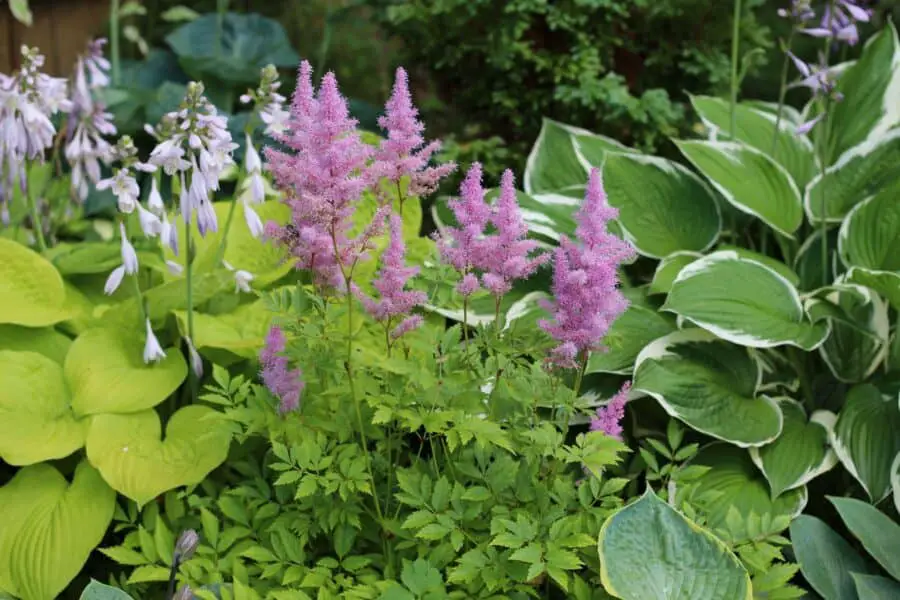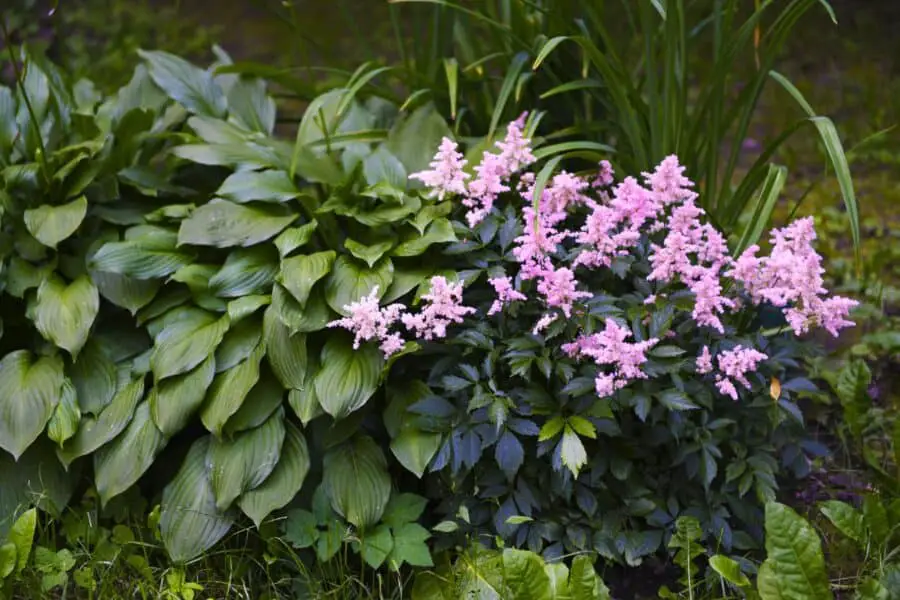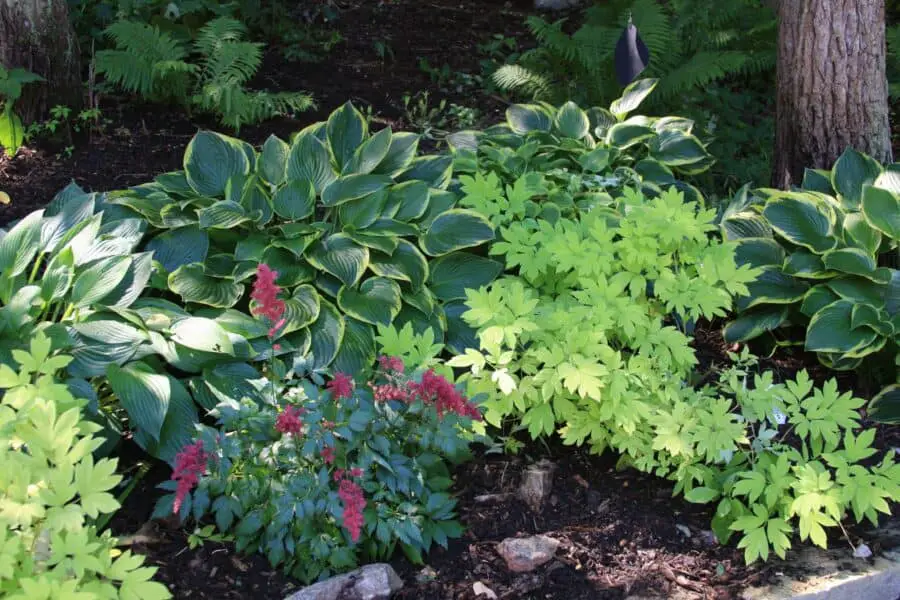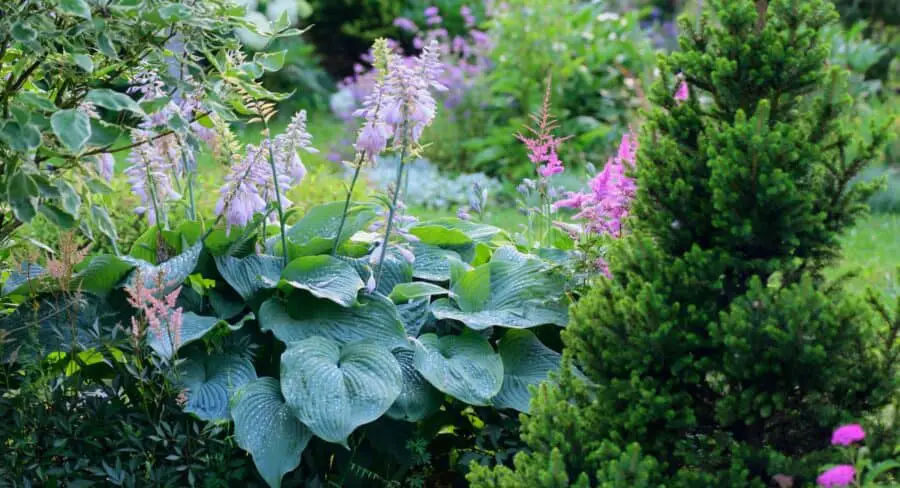As you plan your hosta and astilbe garden, consider the variety of cultivars available and their unique characteristics.
Hostas, known as the potato chips of plants, are diverse in size, color, and leaf shape, allowing you to mix and match to create eye-catching patterns and combinations.
Astilbes, conversely, are known for their plume-like flowers that rise above their fern-like foliage, adding a touch of elegance to your garden.
These shade-loving plants offer a variety of textures and hues with their impressive foliage, making them excellent choices for creating captivating garden designs.
With their reliable growth and suitability for a wide range of climates, you’re guaranteed success when incorporating these beautiful plants into your outdoor space.
Hosta and Astilbe Garden Basics
These perennial plants thrive in shady areas and are relatively low-maintenance, making them an excellent choice to enhance your landscape.
Soil and Sunlight Requirements
Both hosta and astilbe plants prefer well-draining soil rich in organic matter. Before planting, amend your garden soil with compost or other organic materials to improve its structure, nutrient content, and ability to retain moisture.
As for sunlight, hostas thrive in full shade to filtered sun, with larger varieties often having a higher tolerance for sun exposure.
On the other hand, Astilbes should be grown in partial shade to shade with filtered sunlight. However, they can tolerate full sun in northern zones.
Watering and Fertilizing
Both hosta and astilbe plants need consistent moisture to stay healthy and lush. Water your hosta and astilbe plants regularly, particularly during dry spells, to ensure they receive enough water.
A layer of mulch around the base of the plants can also help retain soil moisture and suppress weeds.
Both astilbes and hostas will benefit from an application of slow-release fertilizer in the spring.

Designing Your Hosta and Astilbe Garden
Designing a beautiful hosta and astilbe garden comes down to the thoughtful consideration of color, texture, and the inclusion of other companion plants. Here are some suggestions to help you create an appealing space.
Color and Texture Combinations
Mix and match colors and textures to create visual interest when choosing astilbes and hostas for your garden. Consider the following ideas:
Pair hostas with variegated foliage with astilbes featuring bold, solid-colored foliage for dramatic contrast.
Combine astilbes with striking, feathery plumes in different colors (red, pink, purple, or white) with complementary hosta leaf colors.
Alternate between hostas with large, smooth leaves and those with wavy or puckered edges to add variety in leaf texture.
Incorporating Other Plants
Showcasing hostas and astilbes alongside other shade-loving plants can elevate the beauty and interest of your garden. Here are some plant pairing ideas:
[table id=21 /]
Remember, when incorporating other plants into your hosta and astilbe garden, pay attention to each plant’s specific needs regarding soil, moisture, and sunlight to ensure a healthy, thriving garden.

Planting and Spacing Tips
Preparing the Soil
Before planting the garden, it’s important that you prepare the soil properly. Start by loosening the ground to a depth of 12 inches if possible. Then, mix in organic compost to improve drainage and add nutrients.
Planting Techniques
It would be best to plant both early in the spring or at least 30 days before the first frost in the fall.
When planting astilbes, dig a hole three times the size of the plant to encourage root development. Fill the hole with water, and allow it to sink before placing the plant into the hole.
Plant both hostas and astilbes at the same soil level they were previously in. Water the plants well immediately after planting to help them establish.

Maintaining Your Garden
Proper care helps bring the best out of your hosta and astilbe garden. This section will discuss essential maintenance practices that will ensure a flourishing garden.
Pruning and Deadheading
Pruning is unnecessary for astilbe plants, as deadheading will not encourage repeat blooming. However, you can trim away any dried or damaged foliage to keep the plant looking clean and healthy.
On the other hand, hostas can benefit from light pruning. Regularly remove any wilted or dead leaves to encourage the growth of new, healthy foliage.
Additionally, snipping off the flower stalks after they have faded can help divert energy toward the plant’s foliage.
Pest and Disease Management
Astilbes are known for being virtually pest-free and low maintenance. Hostas, on the other hand, are plagued by slugs, and you need to be vigilant to keep them under control.
Both plants are not usually bothered by diseases. Here are a few tips to ensure these plants stay healthy and avoid diseases.
Practice good garden hygiene by removing fallen leaves or debris that might harbor pests or serve as breeding grounds for diseases.
Ensure proper spacing between plants, as adequate air circulation can help minimize the risk of diseases.
Water your plants consistently, but avoid over-watering, as soggy soil conditions can lead to root rot and other fungal infections.
By following these straightforward maintenance tips, your hosta and astilbe garden will be stunning, healthy, and thriving.

Creating Seasonal Interest
Bloom Times
When designing your astilbe and hosta garden, consider the bloom times of the different varieties to create a visually stunning display all season long. Both plants offer a range of bloom times, which allows you to create a continuous display of color.
For example, astilbes bloom earlier, typically from late spring to early summer. You can extend the flowering period by spacing out your astilbe planting with different varieties.
On the other hand, hostas generally bloom from mid to late summer, offering lovely purple or white flowers on tall stalks.
A well-thought-out garden plan will have astilbes providing color and interest earlier in the season, with hostas taking over as the astilbes fade.
This transition between the two plants’ blooming periods will keep your garden vibrant throughout the growing season.
Foliage Changes
In addition to the blooms, the foliage of astilbes and hostas plays a significant role in creating seasonal interest in your garden.
Astilbes feature fern-like foliage that starts as bronze or reddish hues in early spring and turns into an attractive green as the season progresses.
Meanwhile, hostas are known for their lush, vibrant foliage, which comes in shades of green, blue, and gold.
As the seasons change, so does the color and texture of the foliage. By selecting astilbe and hosta varieties with contrasting leaf colors and shapes, you can create a visually stimulating garden that looks beautiful even when the plants are not blooming.
For example, you can pair blue-leaved hostas with light green or bronze-colored astilbes for a striking contrast.
Experiment with different combinations to achieve a visually appealing display throughout the season.
With careful planning and thoughtful plant selection, your astilbe and hosta garden will provide seasonal interest and a delightful spectacle for all to enjoy.
